The end of 2014 was a busy period for Japan’s Government Pension Investment Fund (GPIF). The fund overhauled its asset allocation and will be putting 50 percent of its assets in equities while cutting its bond holdings.
In a related move, the fund will be looking for a new crop of money managers to handle investment duties, and the GPIF is willing to shell out more money for better talent.
Businessweek reports that the GPIF could begin recruiting managers officially next month. From Businessweek:
Japan’s Government Pension Investment Fund may use a private seminar next month to inform potential job applicants as part of its efforts to recruit professional money managers to the world’s largest investor of retirement savings.
Yasuhiro Yonezawa, chairman of the investment committee at the $1.1 trillion fund, is expected to discuss GPIF’s reforms and the qualifications it wants from future staff, said Nobukiyo Akiyama, an executive at Kotora Co., a Japanese executive search firm that’s organizing the Feb. 13 event.
GPIF is seeking to hire experienced investors as it shifts to riskier assets from bonds in anticipation of faster inflation under Prime Minister Shinzo Abe. Hiromichi Mizuno, a former partner of London-based private-equity firm Coller Capital Ltd., became its first chief investment officer this month.
“The fund will have to obtain professionals that have know-how and skills for private equity, venture capital and real-estate investments following the reform, besides back-office staff,” Akiyama, manager of the chief executive officer’s office at the Tokyo-based executive search firm, said in an interview yesterday. “That’s a very specialized area.”
Kotora, which has 20,000 job seekers registered with the firm, plans to invite 80 individual and corporate clients from the asset-management industry to the seminar, which will be held in Tokyo, Akiyama said.
[…]
The pension fund won flexibility last year to pay higher salaries to attract investment staff instead of government officials.
The GPIF plans to hire about 40 new managers, according to Businessweek.
The fund manages $1.1 trillion in assets and is the largest pension fund in the world.
Photo by Ville Miettinen via Flickr CC License









